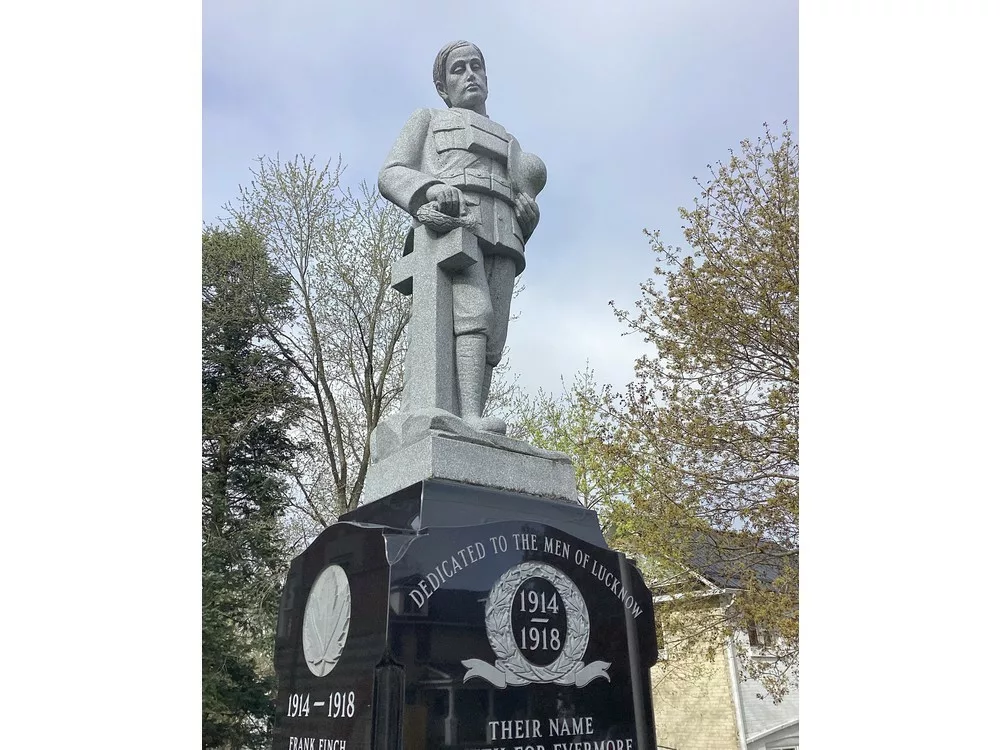
Article content
When the guns fell silent Nov. 11, 1918, the Dominion of Canada began to mourn its war dead.
Advertisement 2
Story continues below
Article content
With more than 63,000 killed and another 173,000 wounded, mourning the young nation’s losses was a painful yet necessary step to healing. Every city, town, village and hamlet in the country chose in their own way to honour their dead. In Lucknow, the soldier cenotaph on Campbell Street just west of the public library became that village’s expression of grief — but only after much controversy.
Article content
In March 1919, the Lucknow Sentinel reported that “a movement for the erection of a Soldiers’ Memorial to those from the Lucknow area who had sacrificed their lives in the Great War had already made considerable progress.” The Lucknow Fire Company, “which did such splendid patriotic work during the war,” had started a memorial fund with a $300 donation. The fire company also sponsored a Chautauqua Festival of three days and nights of professional entertainment at the town’s Carnegie Hall to raise funds for the Soldiers’ Memorial.
Advertisement 3
Story continues below
Article content
A public meeting was called for March 31, 1919, to discuss the subject “of erecting a monument in memory of our deceased soldiers having fallen victims to the ravages of the great European war” to further freedom’s cause “for their fellow men.” It was a lofty sentiment, but what form should that memorial take?
Two years later, in February 1921, the village was still arguing over what type of memorial Lucknow wanted as a monument to their slain. Earlier, the town had proposed a community memorial hall. Proponents of this idea believed the hall would contain three elements: an amusement room with a billiards table and other indoor games; a rest room where visitors could relax; and a gymnasium. A bronze tablet bearing the names of the fallen would be prominently displayed to their memory before the town. However, it was pointed out that pool rooms lent themselves to games of chance and did not promote the patriotic values befitting the fallen. Besides, Lucknow already had a recreational hall with a library and, thus, a memorial hall was redundant.
Advertisement 4
Story continues below
Article content
While town leaders fought over the memorial’s form, the fire company continued to raise money, while church groups and social organizations held teas, staged concerts and other fundraising events to erect an appropriate monument to their war dead. After the memorial hall concept was rejected, by October 1921, it seemed that a memorial park was the preferred monument, so fundraising functions were directed at establishing one.
The Sentinel encouraged readers to make every effort to buy tickets to the fire company’s Masquerade Ball in their undertaking of making Havelock Street Park “a model flower garden” in “honour of Lucknow’s fallen heroes.” Yet, by January, one frustrated Sentinel letter writer asked “Why? Why? Why? Why have a monument to commemorate the soldier boys who fell in battle that will be hidden under snow for five months of the year?”
Advertisement 5
Story continues below
Article content
Another correspondent agreed, arguing the cost of upkeep and maintenance was too expensive for just a few months of the year. A memorial park would fail to keep the soldiers’ memory before the minds of future generations. His proposal was a memorial clock on the town hall or library that would be visible year-round and on the hourly chime to remind the village of the fallen.
In 1922, the park idea was dead, and still nothing had been decided on a soldiers’ memorial. It was still “a live question,” according to the Sentinel, which provoked much emotion. Some still preferred the community town hall, others the clock or the park. Fierce opposition to any of the proposed memorial concepts paralyzed action.

A Sentinel reporter gently condemned both the town hall or clock ideas, contending that “a town hall or a clock” might be “useful things and necessary” but “they would be regarded in no other light than simply a town hall or clock so far as the stranger or future generations would be concerned,” in which case “the town would not have a soldiers’ memorial at all.”
Advertisement 6
Story continues below
Article content
Instead, the Sentinel proposed “a shaft or tablet” that “could have no other reason for existence than to serve as a memorial, and while such remains intact and, in a position, to be seen they could not be viewed in any other light than as a tribute of respect to the fallen.”
In 1928, after nearly a decade of debate, “all Lucknow citizens” according to the Sentinel, felt that action in erecting “a suitable soldiers’ memorial has been too long delayed.” The delay, the paper stated, was not due to “any want of gratitude or patriotic feeling” but to the inability to decide upon what form the memorial should take.
At a public meeting in February in the United Church basement, the town clock proposal was put up for debate. The debate over the town clock memorial was followed by another proposal in the form of an amendment that favoured a “cenotaph.” After “an interesting discussion” the Sentinel reported the townspeople voted on a cenotaph (meaning empty tomb) structure for a soldiers’ memorial. Henceforth, the soldiers’ memorial was referred to as the cenotaph.
Advertisement 7
Story continues below
Article content
In 1928, the Lucknow Women’s’ Institute began collecting the names of the fallen to be carved into the cenotaph. They decreed the names “should only be those of men whose death was due to incidents of their war service and whose family home was in Lucknow at the time of their enlistment, so that they may be said to have belonged to Lucknow.” It was a narrow interpretation of the Lucknow area’s war dead.
When the cenotaph was dedicated on Nov. 11, 1929, only the names of Lucknow villagers who made the ultimate sacrifice were inscribed on a black granite shaft raised on white stone. Under overcast skies, the Sentinel described the ceremony as “solemn, impressive and very appropriate.” Maj. Tolmie, formerly of the Bruce Battalion, spoke of the cenotaph’s significance. Afterwards, a firing party from Goderich fired three volleys as the Union Jack unveiled the Lucknow cenotaph shaft.
Advertisement 8
Story continues below
Article content
The cenotaph was not quite complete. The white marble effigy of a mourning soldier by the cross of a fallen comrade had not arrived from Italy, where it was being carved. Not until the 1930 Armistice Day commemoration that the Lucknow cenotaph was finally in place for was the cenotaph complete.
The Second World War added another 20 names to Lucknow’s cenotaph in 1946, further reminding the area of the cost of freedom. In 1972, a walkway and new electric lighting were installed making the cenotaph more accessible to the public
Due to age, Royal Canadian Legion Branch 309 Lucknow replaced the soldier effigy in 2012 with a new one, thereby extending its life well into the 21st century. The original soldier monument stands guard outside the Lucknow legion
Advertisement 9
Story continues below
Article content
In 2015, Anita Frayne of Ashfield Township, on behalf of her family, approached the Lucknow legion about including the names of the Ashfield Township fallen memorialized on Lucknow’s cenotaph. The Lucknow legion obliged and 11 names of fallen Ashfield servicemen were inscribed on the Lucknow cenotaph. At long last, the names of the Ashfield Township men who had made the supreme sacrifice were inscribed on a cenotaph. The Lucknow cenotaph is the only local monument officially to display the names of the fallen from two counties, Huron and Bruce.
It may have taken time and much debate. but the Lucknow and area cenotaph, after almost a century, is a fitting expression of the area’s grief and a monument of which the village’s sublime sacrifices may justly be proud.
Article content









Comments